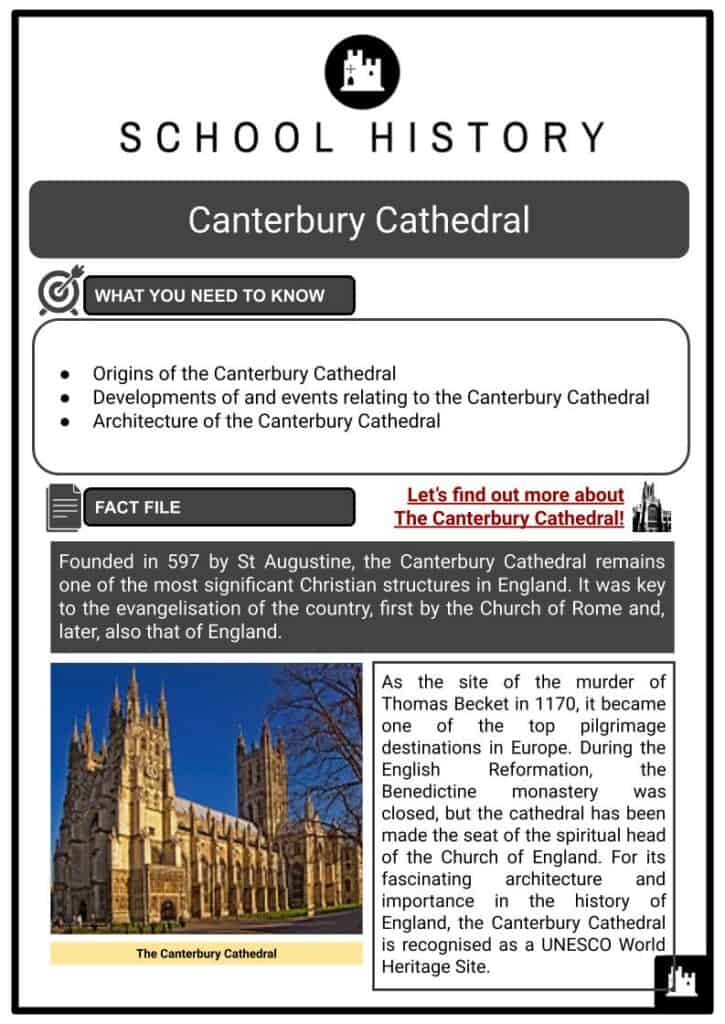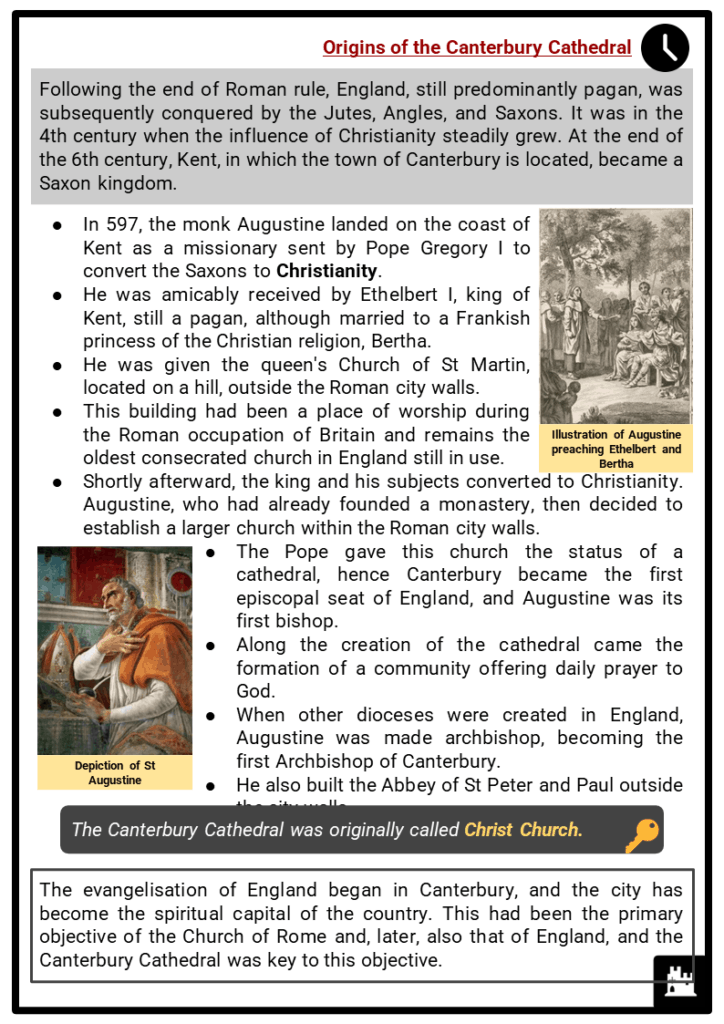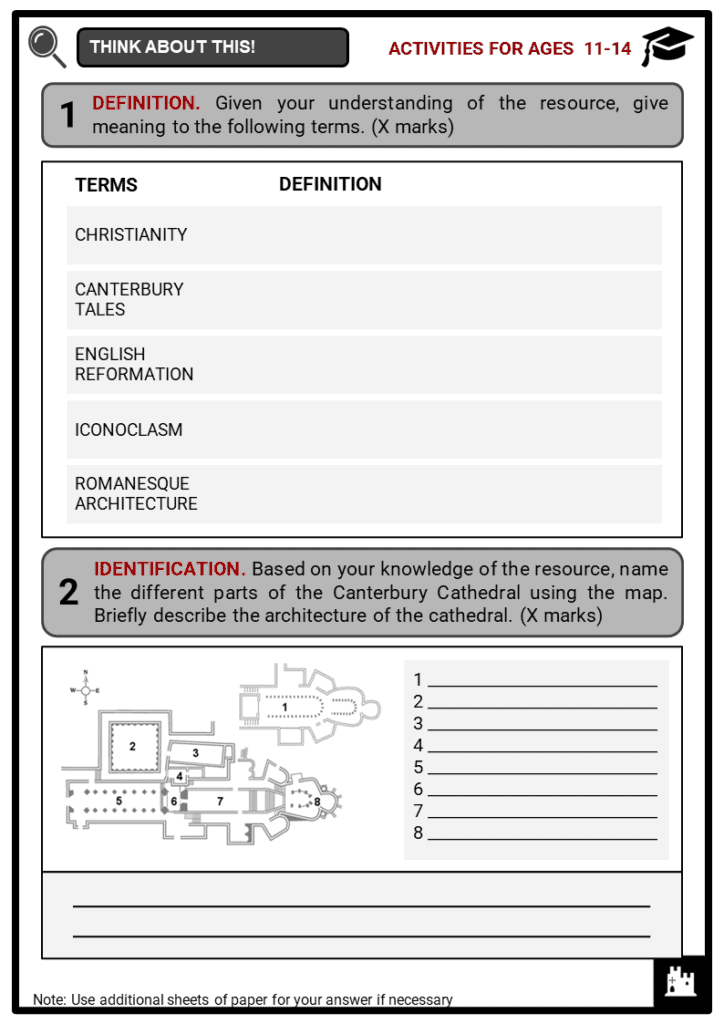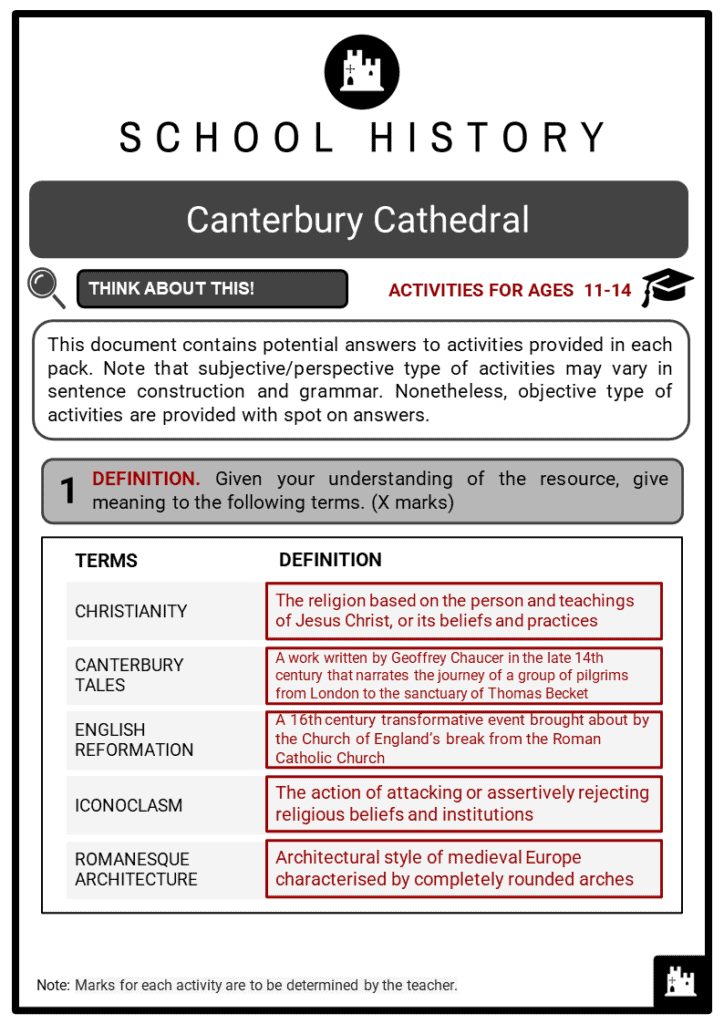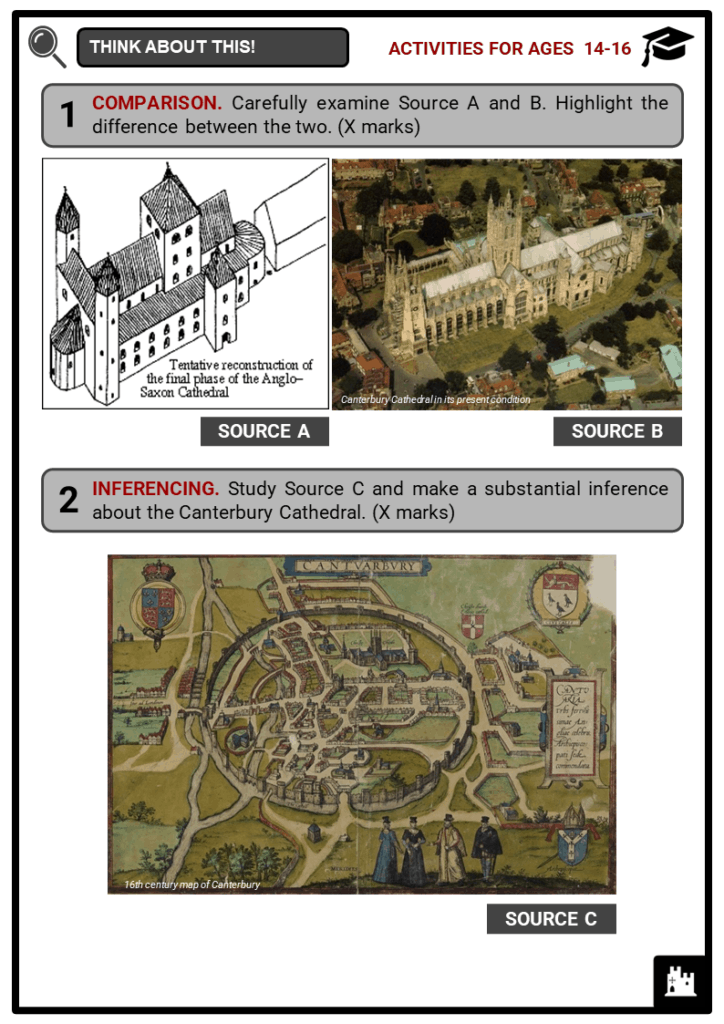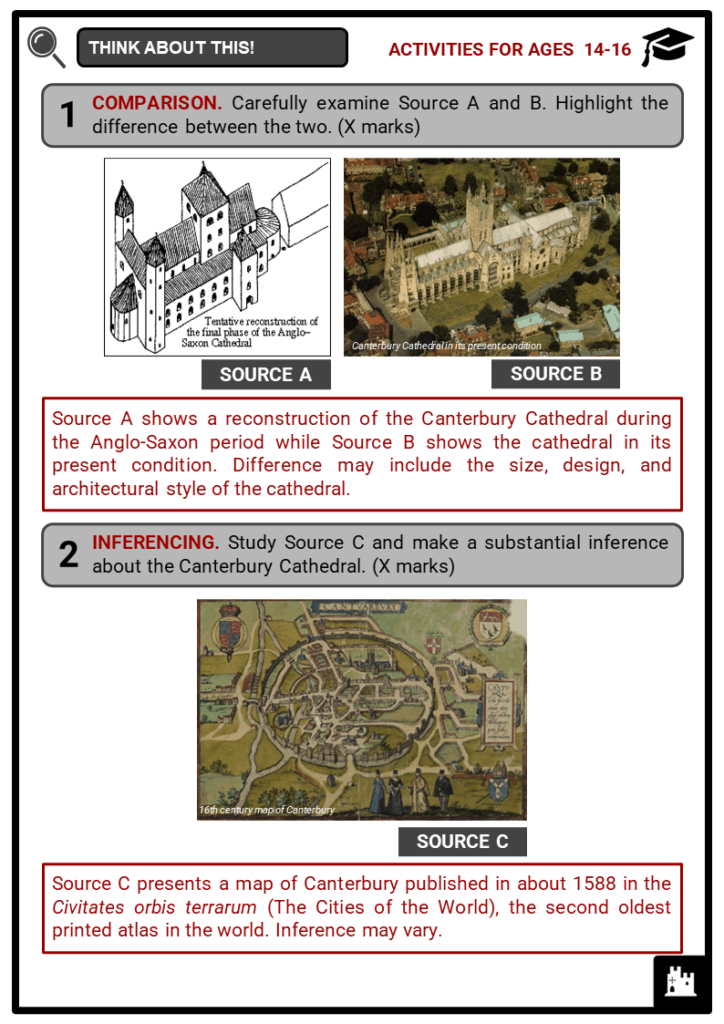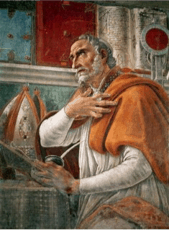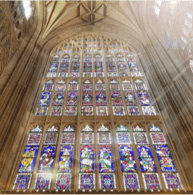Download Canterbury Cathedral Worksheets
Do you want to save dozens of hours in time? Get your evenings and weekends back? Be able to teach Canterbury Cathedral to your students?
Our worksheet bundle includes a fact file and printable worksheets and student activities. Perfect for both the classroom and homeschooling!
Table of Contents
Add a header to begin generating the table of contents
Summary
- Origins of the Canterbury Cathedral
- Developments of and events relating to the Canterbury Cathedral
- Architecture of the Canterbury Cathedral
Key Facts And Information
Let’s find out more about The Canterbury Cathedral!
- Founded in 597 by St Augustine, the Canterbury Cathedral remains one of the most significant Christian structures in England. It was key to the evangelisation of the country, first by the Church of Rome and, later, also that of England.
- As the site of the murder of Thomas Becket in 1170, it became one of the top pilgrimage destinations in Europe. During the English Reformation, the Benedictine monastery was closed, but the cathedral has been made the seat of the spiritual head of the Church of England. For its fascinating architecture and importance in the history of England, the Canterbury Cathedral is recognised as a UNESCO World Heritage Site.
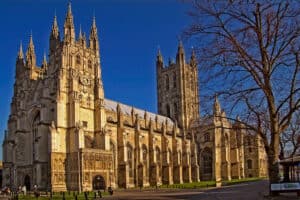
Origins of the Canterbury Cathedral
- Following the end of Roman rule, England, still predominantly pagan, was subsequently conquered by the Jutes, Angles, and Saxons. It was in the 4th century when the influence of Christianity steadily grew. At the end of the 6th century, Kent, in which the town of Canterbury is located, became a Saxon kingdom.
- In 597, the monk Augustine landed on the coast of Kent as a missionary sent by Pope Gregory I to convert the Saxons to Christianity.
- He was amicably received by Ethelbert I, king of Kent, still a pagan, although married to a Frankish princess of the Christian religion, Bertha.
- He was given the queen's Church of St Martin, located on a hill, outside the Roman city walls.
- This building had been a place of worship during the Roman occupation of Britain and remains the oldest consecrated church in England still in use.
- Shortly afterward, the king and his subjects converted to Christianity. Augustine, who had already founded a monastery, then decided to establish a larger church within the Roman city walls.
- The Pope gave this church the status of a cathedral, hence Canterbury became the first episcopal seat of England, and Augustine was its first bishop.
- Along the creation of the cathedral came the formation of a community offering daily prayer to God.
- When other dioceses were created in England, Augustine was made archbishop, becoming the first Archbishop of Canterbury.
- He also built the Abbey of St Peter and Paul outside the city walls.
- The Canterbury Cathedral was originally called Christ Church.
- The evangelisation of England began in Canterbury, and the city has become the spiritual capital of the country. This had been the primary objective of the Church of Rome and, later, also that of England, and the Canterbury Cathedral was key to this objective.
Developments of and events relating to the Canterbury Cathedral
- The Canterbury Cathedral remains one of the oldest and most famous Christian structures in England. Following its foundation in the 6th century, English rulers converted to Christianity and the English Church flourished. The building underwent reconstruction through the centuries and was expanded more and more, thus creating the present Canterbury Cathedral. Described as 'England in stone', the history of the cathedral was intrinsically linked to the history of England.
- 597 - Augustine arrived in Kent and soon established the first Cathedral.
- 997 - A Benedictine monastery was formally founded during the reforms of Archbishop Dunstan. Prior to this, an abbey was added to the cathedral.
- 1012 - The cathedral was plundered and burned by Danish raiders and Archbishop Alphege was kidnapped and killed.
- 1067 - A year after the Norman invasion, fire destroyed the cathedral.
- 1070-1077 - Archbishop Lanfranc oversaw the rebuilding of the cathedral. The cathedral was reconstructed to a design based closely on an abbey in Caen, where Lanfranc was previously an abbot.
- 1098-1130 - The new quire was built over an elaborately decorated crypt. It took the form of a complete church in itself. The rebuilding and improvement were supervised by the priors since Archbishop Anselm was twice exiled from England.
- 1170 - The murder of former chancellor and Archbishop Thomas Becket was a pivotal moment in the cathedral's history. Due to frequent tensions with the king, the archbishop was killed in the cathedral by the four knights of Henry II. He was canonised in 1173.
- The assassination of Archbishop Thomas Becket made the cathedral one of the top pilgrimage destinations in Europe.
- 1175-1184 - The quire was rebuilt after it was damaged by fire the previous year. The French architect William of Sens took care of its reconstruction, having decided to entirely rebuild the building in the Gothic style. The eastern crypt, Trinity and Corona or Becket's Crown Chapels were added.
- 1220 - Thomas Becket’s remains were placed in a new Shrine in Trinity Chapel. The pilgrimages to the tomb of Becket, which was regarded as a place of healing, brought great prosperity to the city and its cathedral for centuries. In fact, the income from pilgrims largely paid for the subsequent rebuilding of the cathedral and its associated buildings.
- The incredibly famous Canterbury Tales, written in the late 14th century by Geoffrey Chaucer, narrates the journey of a group of pilgrims from London to the sanctuary of Thomas Becket.
- One of the most famous tomb within the cathedral is that of Edward the Black Prince, the eldest son of Edward III. While on his deathbed in 1376, he asked to be buried in the crypt. In front of the tomb of the Black Prince, other two royal figures are buried: Henry IV and his queen, Joan of Navarre.
- 1377-1405 - The nave was demolished and rebuilt as seen today. The cathedral was seriously damaged by the 1382 Dover Straits earthquake. The cloisters were repaired and remodelled.
- 1430-1455 - The south transept apse was removed to make way for a chapel, and the north transept apse was replaced by a Lady Chapel. The Pulpitum Screen was also constructed.
- 1498 - Bell Harry Tower was extended, and the cathedral was largely complete as seen today.
- 1538-1541 - During the English Reformation, Thomas Becket’s shrine was destroyed on orders of Henry VIII and the relics were lost.
- The importance of the cathedral was reduced due to the abolition of religious orders and the cult of saints. The monastery was dissolved by royal command, and the king removed the prior and the monks. The abbey of St Augustine was closed. The New Foundation of Dean and Chapter was established. Since the order of bishops was retained following England's break from the Roman Catholic Church, the cathedral remained as the seat of the bishop and has become the seat of the spiritual head of the Church of England. Thomas Cranmer became the first Protestant archbishop of Canterbury; Reginald Pole was the last Roman Catholic archbishop of Canterbury who held the office during the Counter-Reformation.
- 1660-1704 - During the English Civil War, the cathedral suffered significant damage due to Puritan iconoclasm, in which sacred images, stained-glass windows, and tombs were destroyed. It undertook repair and refurbishing, with the Christ Church gate restored. However, the statue of Christ was not replaced until 1990.
- 1834 - The original Norman northwest tower was replaced due to structural concerns. The alteration provided a more symmetrical appearance for the cathedral.
- 1954 - Although the cathedral did not sustain extensive damage during the bombing raids of the Second World War, its library was destroyed and then rebuilt.
- 1986 - A new Martyrdom Altar was installed in the northwest transept, on the spot where Thomas Becket was assassinated.
- 1988 - The cathedral, the Church of St Martin and the ruins of St Augustine's abbey have been listed in the UNESCO World Heritage Sites.
- 2015 - The cathedral saw, for the first time, the ordination of female bishops namely Sarah Mullally, Bishop of Crediton, and Rachel Treweek, Bishop of Gloucester.
Architecture of the Canterbury Cathedral
- The architecture of the Canterbury Cathedral is the result of the fusion between two architectural styles: the Romanesque style and the Perpendicular Gothic style.
- Defined by the completely rounded arches, the Romanesque style was used in the eastern side of the cathedral including the nave and part of the quire.
- On the other hand, the Perpendicular Gothic style, which is characterised by the slightly pointed arches and pinnacle, was used in the western side that consists of the quire and the Trinity Chapel.
- The cathedral was built with Caen stone, a stone mined in France, which gives the building a creamy-yellowish colour.
- A large staircase unites the eastern and western side of the church.
- The beauty of its architecture is complimented by a set of exceptional early stained-glass windows which constitute the most magnificent collection in the United Kingdom.
- Recent research suggests that some of the stained-glass windows from the Canterbury Cathedral may be among the oldest in the world.
Image sources:

